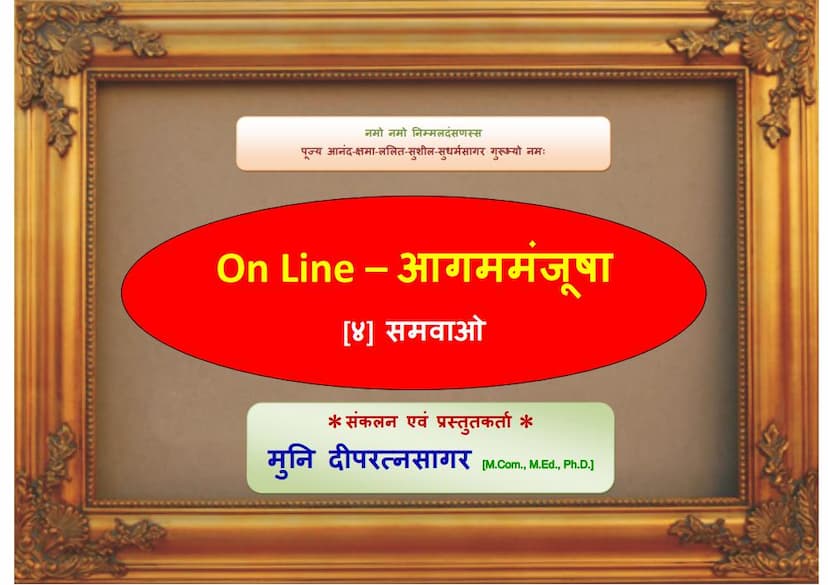Aagam Manjusha 04 Angsuttam Mool 04 Samavaao
Added to library: September 1, 2025

Summary
Here's a comprehensive summary of the provided Jain text, Aagam Manjusha 04 Angsuttam Mool 04 Samavaao, based on the transcribed pages:
Book Title: Aagam Manjusha 04 Angsuttam Mool 04 Samavaao Author(s): Anandsagarsuri, Sagaranandsuri Publisher: Deepratnasagar
Overview:
This text is the fourth Anga (part) of the Jain Agamas, known as the Samavaaya (or Samavaayo). It is presented as part of the Aagam Manjusha series, which was originally compiled about 70 years prior to the 2012 online edition. The online version aims to make this important Jain scripture accessible through the internet, incorporating some modifications to the original compilation.
Key Themes and Content:
The Samavaaya Anga, as presented in this excerpt, focuses on enumerating and categorizing various Jain concepts, quantities, and entities. The text systematically lists numbers from one upwards and associates them with different elements of Jain cosmology, philosophy, and practice.
Core Structure and Content Breakdown:
The excerpt reveals a pattern of numerical enumeration followed by specific Jain concepts or entities associated with that number. Here's a breakdown of the types of information presented:
-
Cosmic and Astronomical Elements:
- Numbers of Celestial Bodies: Mentions constellations (Nakshatras) associated with specific numbers (e.g., 7 Nakshatras associated with the moon's movement).
- Planetary and Stellar Ascendancy: References specific nakshatras like Mrigashirsha, Ardra, Pushya, etc., being "todore" (possibly referring to their influence or sequence).
- Cosmic Structures and Geography: Details measurements of various realms, mountains (e.g., Meru, Himavant), islands (e.g., Jambudvipa), oceans, and distances within the Jain universe.
- Lifespans and Durations: Specifies lifespans (sthiti) of beings in different realms, particularly hellish beings (Narakis) and celestial beings (Devas) in various heavens (Kapalas), measured in years, half-months, or periods like Palya and Sagaropama.
-
Jain Ontological Categories:
- Dravyas (Substances): Mentions the five astikayas (Dharmastikaya, Adharmastikaya, Akashastikaya, Jiwastikaya, Pudgalastikaya).
- Samyakdarshan and Moksha: Lists elements related to right faith and liberation.
- Asrava and Samvara: Details the influx of karma and its stoppage.
- Bondage and Liberation: Mentions bondage (bandha) and liberation (moksha).
- Virtues and Practices: Lists concepts like the five great vows (Pancha Mahavratas), five senses (Pancha Indriyas), five types of karma influx (Pancha Asravadaras), five types of karma stoppage (Pancha Samvaradaras), six classes of souls (Shad Jivnikayas), six types of meditation (Shad Dhyanas), and different kinds of austerity (Bahya and Abhyantara Tapas).
-
Jain Doctrine and Philosophy:
- Kashayas (Passions): Lists the four passions (Krodha, Mana, Maya, Lobha).
- Kriyas (Activities): Enumerates five types of actions or activities (Pancha Kriya).
- Upayoga (Application): Mentions eight types of Upayoga and various stages of spiritual development (e.g., Samyaktva, Virati, Pramada, etc.).
- Darshan (Perception/Faith): Discusses right faith, wrong faith, and mixed faith.
- Yoga: Mentions different types of yoga.
- Moksha (Liberation): Refers to beings who will attain liberation in a certain number of lifetimes.
- Nirjara (Shedding of Karma): Mentions various means of karma shedding.
- Tattvas (Principles): Touches upon fundamental Jain principles.
-
Specific Jain Entities and Concepts:
- Tirthankaras: Mentions the number of Tirthankaras in different epochs and their parents.
- Gadhadharas and Ganadharas: Refers to the disciples and chief disciples of the Tirthankaras.
- Chakravartis, Baladevas, Vasudevas: Lists numbers associated with these powerful figures.
- Bodily Forms: Discusses different types of bodies and their characteristics.
- Karma: Details the number of karma types, sub-types, and their durations.
- Vows and Conduct: Enumerates different stages of vows and conduct.
- Samitis and Guptis: Lists the five restraints and three controls.
- Lesya (Color of the Soul): Mentions the six types of Lesya.
-
Numerical Structure and Repetition: The text is characterized by its systematic listing of numbers, often followed by repetitions of related concepts or entities. For example, it will list "one..." then detail various single entities, then "two..." and list dualistic concepts, and so on, up to higher numbers. This repetition emphasizes the comprehensive nature of the enumeration.
Purpose and Significance:
The Samavaaya Anga is crucial for understanding the Jain cosmological and philosophical framework. Its systematic enumeration helps in:
- Quantifying the Universe: Providing a numerical understanding of the vastness and complexity of the Jain cosmos.
- Classifying Jain Doctrines: Organizing various spiritual, ethical, and cosmological principles into quantifiable categories.
- Developing Analytical Skills: The detailed lists encourage memorization and comprehension of key Jain concepts.
- Foundation for Further Study: Serving as a foundational text for deeper exploration of Jain philosophy.
Editorial Notes (from the online edition):
The introductory section highlights that this online edition is presented 70 years after the original compilation by Acharya Shri Anandsagar Suri. It also notes some specific variations in the current edition compared to the original Aagam Manjusha, such as the inclusion of commentaries (Yukti, Bhashya) along with original sutras for some texts and the inclusion of alternative Agamas.
Overall:
The provided excerpt of the Samavaaya Anga is a highly detailed and numerical text that systematically enumerates and categorizes a vast array of Jain concepts, cosmic elements, lifespan durations, and philosophical principles. It serves as a foundational text for understanding the quantitative and classificatory aspects of Jain cosmology and doctrine.